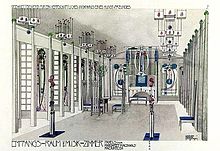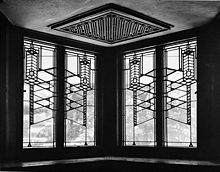
Back Интериорен архитект Bulgarian Arquitectura de interiores Spanish معماری داخلی Persian Belsőépítészet Hungarian Inredningsarkitektur Swedish สถาปัตยกรรมภายใน Thai İç mimarlık Turkish Kiến trúc nội thất Vietnamese
This article possibly contains original research. (March 2019) |



Interior architecture is the design of a building or shelter from inside out, or the design of a new interior for a type of home that can be fixed. It can refer to the initial design and plan used for a building's interior, to that interior's later redesign made to accommodate a changed purpose, or to the significant revision of an original design for the adaptive reuse of the shell of the building concerned.[2] The latter is often part of sustainable architecture practices, whereby resources are conserved by "recycling" a structure through adaptive redesign.
Generally referred to as the spatial art of environmental design, interior architecture also refers to the process by which the interiors of buildings are designed to address all aspects of the human use of their structural spaces. Put simply, interior architecture is the design of an interior in architectural terms.
Interior architecture may refer to:
- the art and science of designing and erecting buildings and their interiors, along with other related physical features, by a licensed architect.
- the practice of an interior architect, where architecture means to offer or render professional services in connection with the design and construction of a building's interior that has as its principal purpose relating interiors' design to human occupancy or use.[3]
- a general term to describe building interiors and related physical features.
- a style or method of design and construction for a building's interiors and related physical features.
- the practice engaging work on already existing interior environments, where adaptive re-use and a knowledge of architectural strategies are necessary for re-designing existing space.[4]
- ^ "Frank Lloyd Wright: His Life and His Architecture," Twombly, Robert C., John Wiley and Sons, Inc., 1979, p. 384.
- ^ "Interior Architecture". RISD Interior Architecture Graduate Department.
- ^ "The Nova Scotia Legislature". gov.ns.ca. Archived from the original on 21 July 2011.
- ^ "European Charter of Interior Architecture Training" (PDF). www.ecia.net. 2020.
© MMXXIII Rich X Search. We shall prevail. All rights reserved. Rich X Search